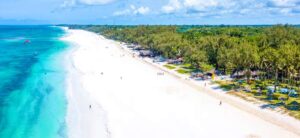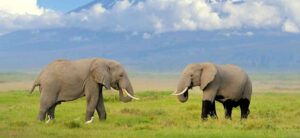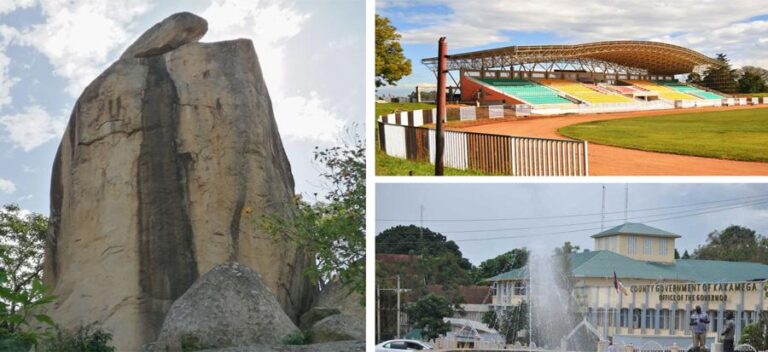Its lush landscape is reminiscent of the Kenyan countryside, with sweeping tea plantations, hiking trails, and unforgettable tourist attractions in national parks. Kenyan national Parks entice young families, culture lovers, and travelers from around the globe.
Kenya, home of the “Big Five,” has incredible, beautiful national parks with savannah grasslands, majestic animals, unique plants, and picturesque views.
For landscape photographers or those seeking the next destination to satisfy your outdoor taste, we have sieved through the Kenyan National Parks and cherry-picked the top 10 you should visit.
Top National Parks in Kenya
#1. Nairobi National Park
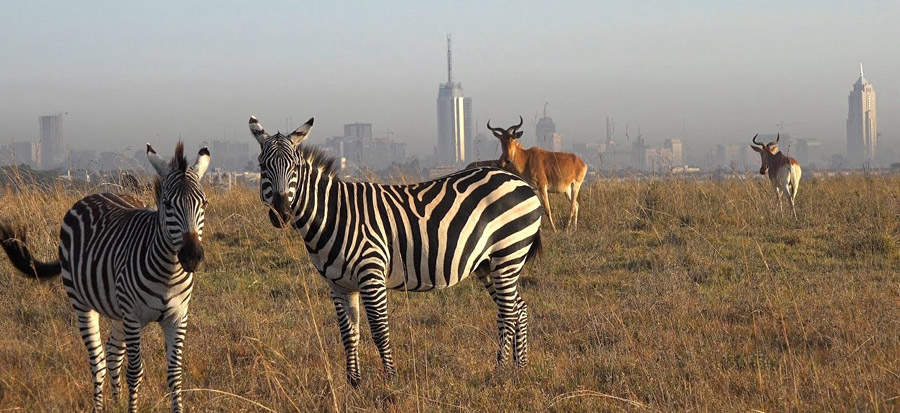
Visiting Kenyan parks is incomplete without walking through the “World’s only Wildlife Capital,” one of the best national parks in Kenya.
Nairobi National Park is known for its proximity to Nairobi’s central business district, characterized by wide-open grass plains and a backdrop of city scrapers. Scattering acacia bush hosts a wide variety of wildlife, including the endangered black rhino, lions, leopards, cheetahs, hyenas, buffaloes, and giraffes. There is also a diverse birdlife with over 400 species recorded.
Visitors can enjoy the park’s picnic sites, three campsites, and the hiking trails.
You can visit Nairobi National Park all year round. Remember to take valuable items like binoculars, a camera, a hat, sunscreen, sunglasses, a guidebook, drinking water, and other picnic items.
Nairobi National Park is located 10km South of Nairobi city center. An Uber will cost you between 500 and 650 Ksh.
Key features
Wildlife
- Animals include Buffalo, giraffe, lion, leopard, baboon, zebra, wildebeest, and cheetah—100 mammal species.
- Four hundred migratory and endemic bird species.
Picnic Facilities
For corporate events, bush dinners, weddings, picnics, team building sessions, video and film production
- Mokoyiet,
- King Fisher
- historic ivory burning site
- Impala
Attractions
- The only Wildlife park in the world that is so close to the city
- Black rhinoceros: which is an endangered species
- The first park to be gazetted in Kenya on December 16, 1946
- Central Rhino Sanctuary for breeding and restocking other parks
- Diverse birdlife: Has over 400 bird species. At least 20 of them are seasonal European migrants.
- Home to over 100 mammal species, four of the Big Five (lion, Buffalo, leopard, and rhino)
- It has a spectacular wildebeest and zebra migration
- Large predators- lion, leopard, hyena, and cheetah.
- Aggregations of large herbivores- eland, Buffalo, zebra, and wildebeest
- Ivory Burning Site Monument
- Walking trails at hippo pools
- Nairobi Safari Walk & the Orphanage.
- Spacious, accommodating picnic sites
#2. Mount Longonot National Park
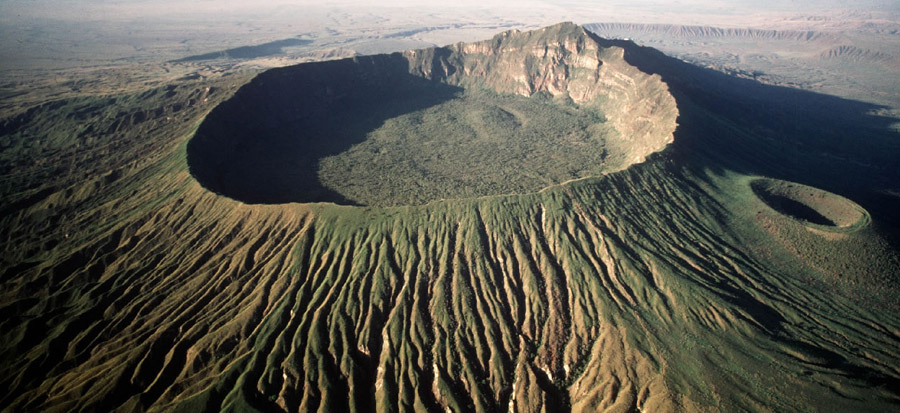
Rising from the floor of the Great Rift Valley like a monolith is the extinct volcano of Mount Longonot. A unique feature is a thick forest within the mountain’s crater.
The crater rim also provides great scenic views across the beautiful Rift Valley to Lake Naivasha. Major wildlife attractions at Mount Longonot include buffaloes, elands, lions, leopards, bushbucks, common zebras, giraffes, and Grant’s gazelles, making it one of the best national parks in Kenya.
You can visit Mount Longonot National Park all year round. Remember to take valuable items like binoculars, a camera, a hat, sunscreen, sunglasses, a guidebook, drinking water, and other picnic items. The park is accessible via tarmac road and 90km from Nairobi city.
Attractions
- Extinct volcano and crater forest, Scenic Landscape, Views of Lake Naivasha and the Great Rift Valley.
- The park is a paradise for birds of prey
Activities in Mount Longonot National Park
- Biking
- Game Viewing
- Hiking
- Rock climbing
- Viewing Lake Naivasha
- Walking
#3. Amboseli National Park
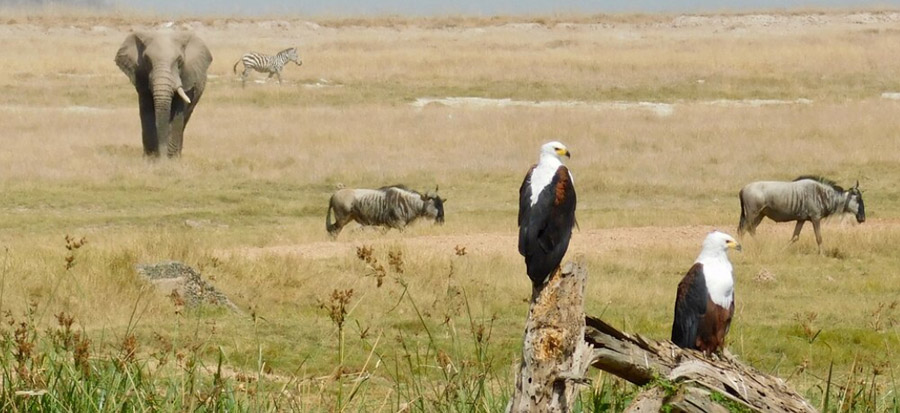
Crowned by Mount Kilimanjaro, Africa’s highest peak, the Amboseli National Park is one of Kenya’s most popular parks. The name “Amboseli” comes from a Maasai word meaning “salty dust,” it is one of the best places in Africa to view large herds of elephants up close.
Nature lovers can explore five different habitats here, including the dried-up bed of Lake Amboseli, wetlands with sulfur springs, the savannah, and woodlands.
They can also visit the local Maasai community around the park and experience their authentic culture. Thus, it is one of the best national parks in Kenya.
Attractions
- Large Herds of Elephants
- Mt. Kilimanjaro
- Big Five
- Observation Hill, which allows an overall view of the whole park, especially the swamps and elephants,
- The swamp below Observation Hill is home to many elephants, buffaloes, hippos, and various waterfowl, including the pelican and Egyptian goose.
- Contemporary Maasai culture and Indigenous lifestyle
Major Attractions: Mount Kilimanjaro; Observation Hill, which allows an overall view of the whole park, esswampsyandps, and elephants; the swamp below observation hill hosts many elephants, buffaloes, hippos, and a variety of waterfowl like pelicans; Egyptian goose; contemporary Maasai culture and Indigenous lifestyle; herds of elephants.
Wildlife: Amboseli has over 80 different mammals to be found, ranging from the tiny (and rarely seen) spectacled elephant shrew to the vast bulk of the African elephant. Few visitors will go home without superb elephant pictures with Kilimanjaro as a backdrop. There are over 400 bird species.
How to get there
- By Road: The main road into the park is from Nairobi via Namanga (240 km) on the Nairobi—Arusha Road through Meshanani gate. The other road is from Nairobi via Emali (228 km) on the Nairobi—Mombasa Road. Access from Mombasa is mainly through Tsavo West National Park via the Kimana (Olkelunyiet) Gate.
- By Air: Airstrips: The Park has a single airstrip for light aircraft at Empusel gate. Other airstrips exist at Kilimanjaro Buffalo Lodge and Namanga town
#4. Maasai Mara National Park
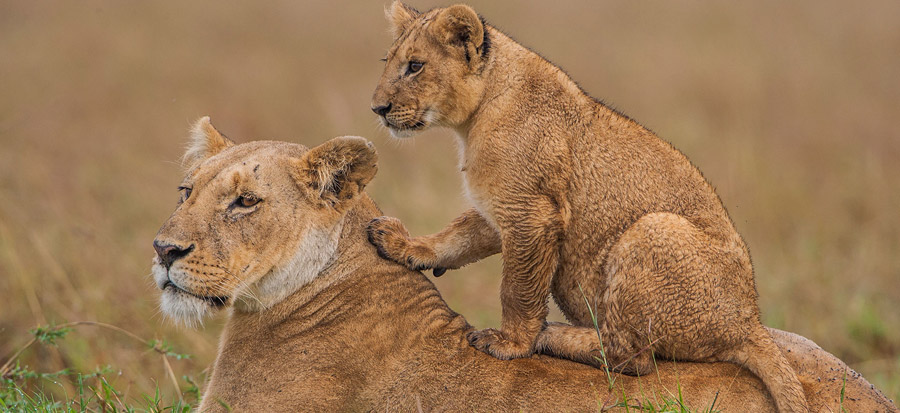
Masai Mara National Reserve is one of the most popular tourist destinations in Kenya- Africa. The reserve is located in the Great Rift Valley and is primarily open grassland.
Wildlife tends to be most concentrated on the reserve’s western escarpment.
The Masai Mara is the jewel of Kenya’s wildlife viewing areas. Over 1.5 million wildebeest migrate there each year, arriving in July and departing in November.
Some 95 species of mammals, amphibians, and reptiles and over 400 bird species have been recorded on the reserve, making it one of the best national parks in Kenya.
Wildlife—Nowhere in Africa is wildlife more abundant. The Mara is known as one of the finest wildlife destinations in the world, with an excellent chance of seeing the Big Five: cheetah, serval, hyena, bat-eared foxes, black-backed and side-striped jackals, hippo, crocodile, baboons, warthog, topi, eland, TThompson’sgazelle, Grant’s gazelle, impala, waterbuck, oribi, reedbuck, and zebra.
Climatic conditions—The Altitude is 5,300 feet (1,600 meters). The rainy season is from November through May, with peak rainfall in December-January and April-May. The dry season is from June to November. There are often sunny mornings with cloud build-up in the afternoons, which develops into thunderstorms in the afternoon and evening during the rains. Maximum temperatures can reach 30°C, and minimum temperatures are around 20°C.
Access – The Mara Triangle is serviced by two all-weather airstrips– Mara Serena and Kichwa Tembo. The primary road access into the Triangle is through Narok and Sekenani Gate.
Accommodation—Mara Serena (150 beds with luxury bedding and cozy pillows) and Little Governors’ Camp (36 beds with luxury bedding and cozy pillows) are the only two lodges in the Triangle. Kichwa Tembo, Mpata Club, Olonana, Mara Siria, and Kilima Camp are on the periphery but use the Triangle.
Best time to visit – Peak season is between July and October, during the migration. Early November and February can also offer excellent game viewing.
Activities: Game viewing, camping, night game drives, visits to Masai cultural villages, ballooning, bush dinner, lunch, and breakfast. Masai Mara is a spot for a destination wedding photographer to engage in different scenes with clients.
#5. Lake Nakuru National Park
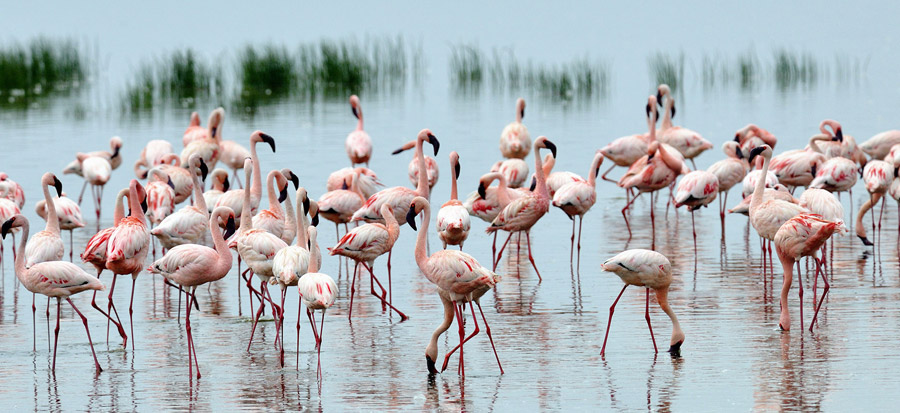
On the floor of the Great Rift Valley, surrounded by wooded and bushy grassland, lies the beautiful Lake Nakuru National Park nicknamed “The Beautiful Wildlife Haven”.
Visitors can enjoy the wide ecological diversity and varied habitats that range from Lake Nakuru itself to the surrounding escarpment and picturesque ridges. Lake Nakuru National Park is ideal for bird-watching, hiking, picnics, and game drives.
Attractions
- Flamingos (Greater and Lesser) and other water birds including a variety of terrestrial birds numbering about 450 species in total.
- Mammals: 56 different species including white rhinos, waterbuck, etc.
- Viewpoints: Lion Hill, Baboon Cliff, and Out of Africa
- Hills: Enasoit, Honeymoon, Lion Hill Ridge, etc
- Waterfalls: Makalia.
- Unique vegetation: About 550 different plant species including the unique and biggest euphorbia forest in Africa, Picturesque landscape, and yellow acacia woodlands.
- Cycle with Rhino event every September yearly
How to get there
- Roads: The Park has a tarmac road connection with Nairobi, 156 km northwest of Nairobi, on the main A104 road. The most commonly used route into the park is via the foremost main Gate, kratom Nakuru Town Centre. It is also possible to enter the park from the main Nairobi Nakuru road at Lanet gate. The Nderit gate is used by people accessing the Park from Masai Mara or Elementaita.
- Airstrips: The Naishi airstrip services the park for tourism and KWS activities.
- Park Roads: The Park has adequate and well-serviced motorable roads that make most parts of the park accessible.
- Park Gates: The Gate of entry is the Lanet gate near the Kenya Pipeline. The main entrance is inaccessible due to rising water levels, which hinder a complete circuit to the park.
#6. Hell’s Gate National Park
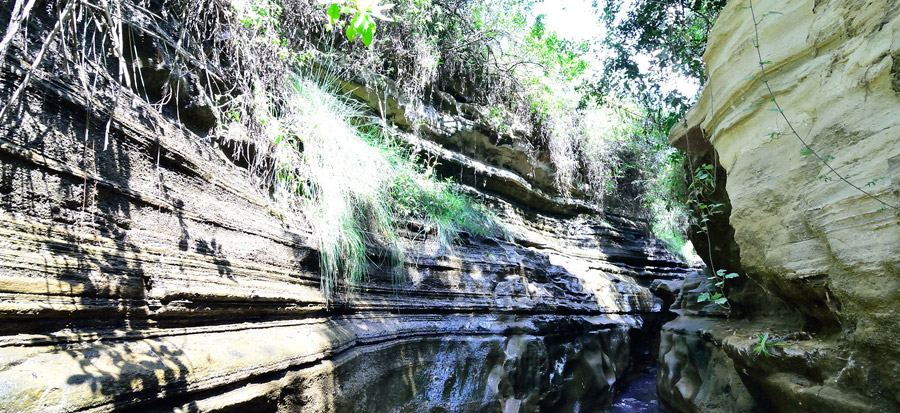
Named for the intense geothermal activity within its boundaries, the Hell’s Gate National Park is a remarkable quarter of the Great Rift Valley. Spectacular scenery including the towering cliffs, water-gouged gorges, stark rock towers, scrub-clad volcanoes, and belching plumes of geothermal steam make it one of the most atmospheric Parks in Africa.
Hell’s GateGatea is a general venue for a day trip from Nairobi. In addition to the bio-diversity, which includes raptors, visitors can enjoy mountain biking, rock climbing, and a natural spa.
Hell’s Gate National Park covers an area of 68.25 square km and is situated in the environs of Lake Naivasha about 90 km from Nairobi. The park is 14 km after the turnoff from the old Nairobi-Naivasha highway.
It is characterized by diverse topography and geological scenery. It is an important home of the lammergeyer (The Bearded Vulture).
Hell’s Gate can be accessed through two main gates: the main Elsa Gate and the Olkaria Gate. The latter also serves the Olkaria Geothermal Station, which is located inside the National Park.
Attractions
- Spectacular scenery including the towering cliffs, water-gouged gorges, stark rock towers, scrub-clad volcanoes, and belching plumes of geothermal steam make it one of the most atmospheric Parks in Africa.
- Wildlife viewing
- Raptor nesting in cliffs
- Hot springs
- The Olkaria Geothermal Station
- The Mervyn Carnelley Raptor Hide
- Tourist circuits, nature trails
- Health spa
How to get there
- By Road: This Park is accessible via tarmac road from Nairobi (90kms) via Naivasha Town on Lake Road South at a junction 5km south of Naivasha
- By Air: Naivasha airstrip
#7. Aberdare National Park
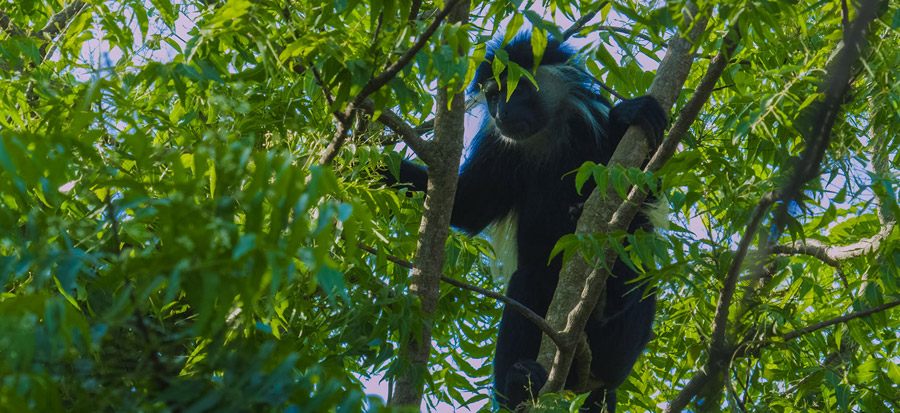
The Aberdares are the third-highest range of mountains in Kenya, reaching a summit of just over 4000m. This massive range is well known for its thick salient forests, and their prolific game.
These high-altitude forests are broken by moorlands and plains, and through the abundant tree cover, there are sensational views of the Rift Valley and the peak of Mt Kenya.
The forest is a hidden world of wildlife. The thick vegetation provides the perfect cover for countless species.
Very large herds of elephants and Buffalo move almost silently through the undergrowth, while overhead noisome birds and colobus monkeys dominate the canopy.
At night the forest comes alive, the cries of hyrax and the distinctive rasping growl of leopard echoing among the trees. The Aberdares has two ‘Tree Hotels’, unique safari lodges set high in the canopy above waterholes, and natural salt licks.
Night sees an unending procession of game emerge from the forests to visit these clearings.
This is an ideal opportunity for guests to unobtrusively observe the game at length. A night in the Aberdares is unforgettable. Elephant herds surround the waterholes, drink, and then fade away into the forest.
Buffalo bulls fight over territory in spectacular battles. Sleek Genet cats descend from the trees and slip through the halls of the lodge. Occasionally a Rhino or the elusive Bongo antelope appears and visits the waterhole.
The Aberdares can also be explored by vehicle or on foot. Trekking trails run throughout the forests and across the moorlands. A few days spent here is one of Kenya’s best forest treks.
The foothills of the Aberdares are ideal for exploring on horseback and there are crystal-clear mountain streams that abound with Trout. The Aberdares are a great place for waterfalls.
There are a series of spectacular falls along the range, and at Nyahururu, Thompson’s Falls has become a popular rest stop for travelers.
Aberdare National Park is characterized by picturesque, steep forested ravines and open moorland. It provides a habitat for elephants, black rhinos, leopards, spotted hyenas, olive baboons, black and white colobus monkeys, buffalos, warthogs, and bushbucks.
Rare sightings include those of the Giant Forest hog, bongo, golden cat, serval cat, African wild cat, African civet cat, and the blue duiker. Visitors can indulge in picnics, trout fishing in the rivers, and camping in the moorlands.
Bird viewing is rewarding, with over 250 species of birds in the park, including the Jackson’s Francolin, Sparrow hawks, goshawks, eagles, sunbirds, and plovers.
Getting Around – Main road access to the Aberdares is via Mweiga or Nyeri, both easily accessed from Nairobi by bus/matatu or private transport.
You’ll need your transport, or to be part of a safari, to get to the forest. Many trekking companies can organize transfers from Nairobi to Mt Kenya. The forest lodges also have daily transfers.
Good roads exist within the park, though a 4WD vehicle is needed during the rainy season. The lodges and hotels here organize game drives. Hiking trails are also available through the Aberdares. A ranger guide is compulsory.
Attractions
- Game animals easily seen in the park during game viewing include; African elephants, black rhinos, leopards, spotted hyenas, olive baboons, black and white colobus monkeys, sykes monkeys, cape buffalo, warthog, common zebra (North Aberdare), bushbuck, reedbuck. Rare sightings include those of the Giant Forest hog, bongo, golden cat, serval cat, African wild cat, African civet cat, and blue duiker.
- The very beautiful sceneries of Aberdare include magnificent waterfalls with the main ones being Karuru waterfalls which fall in three steps, 1st step 117M, 2nd step 26M, and 3rd 130M, making a total of 273M, Chania waterfalls, and many other smaller ones.
- Adding to the beauty of Aberdare are many ridges and river valleys which attract mountain scenery photographers.
- A recently marked attraction in Aberdare is the 400 km electric fence, completed—final post on August 28, 2009. The fence protects the whole Aberdare ecosystem from human pressures and contains wildlife, preventing human/wildlife conflict.
- Visitors can also indulge in picnics, trout fishing (in the past the rivers were stocked with brown rainbow trout) in the rivers, and camping in the Moorlands. Bird viewing is rewarding with about 290 recorded bird species, including the Aberdare Cisticola which is critically endangered, and Jackson’s francolin, which is regionally endemic, sparry hawk, goshawks, eagles, sunbirds, and plovers
#8. Meru National Park
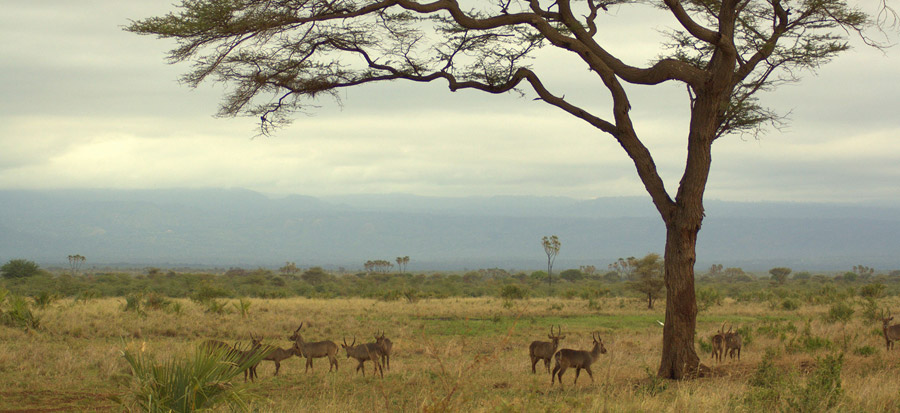
Meru National Park is wild and beautiful. Straddling the equator and bisected by 13 rivers and numerous mountain-fed streams, it is a gorgeous area of Kenya.
It has diverse scenery from woodlands at 3,400ft (1,036m) on the slopes of Nyambeni Mountain Range, northeast of Mt. Kenya, to vast open plains with meandering riverbanks dotted with doum palms.
The game includes lion, elephant, cheetah, leopard, rhino, zebra, gazelle, oryx, and some of the rarer antelope, Lesser Kud, and Duke— also some of Kenya’s largest herds of Buffalo.
The rivers abound with hippos, crocodiles for Barbus, and catfish, permitted at campsites and along the Tana River. In the mid-1980s, the park suffered from poaching; however, KWS armed wildlife security patrols have driven out the poachers, and the elephant population has stabilized, with breeding herds settling down.
Over 300 species of birds have been recorded, including Red-necked falcon, Heuglins courser, brown-backed woodpecker, sunbirds Peter’s Finfoot, inhabiting the Murera and Ura Rivers; Pel’s Fishing Owl, kingfishers, rollers, bee-eaters, starlings, and weavers.
The park is most famous as the setting for Joy Adamson’s book “Born Free,” the story of Adamson’s life and research amongst lions and cheetahs. “Elsa” the lioness was the most well-known and her grave is marked here.
There is one lodge (132 beds) and two tented camps are planned. 8 special campsites must be pre-booked, one public campsite; Elsa camp, KWS self-help bandas, and Leopard Rock bands.
There are two routes to Meru national park from Nairobi. The first is the main road via Nyeri, Nanyuki, and Meru, the second is via Embu-Meru road. It offers the best approach via the Ura gate.
The dry weather route from Meru is through Mathara and Kangeta towards Maua turning left on the Kinna road leading to the National park gate. There are airstrips and leopard rock or Meru Mulika lodge.
Brilliant on a magnificent scale, the Meru and Kora sister parks feature luxuriant jungle, coursing rivers, verdant swamp, khaki grasslands, and gaunt termite cathedrals all under the sky’s great blue bowl.
Little visited and utterly unspoiled, few places are comparable to the remote and rugged atmosphere found here. Visitors can see Grevy’s zebras, elephants, Bohor reedbucks, hartebeests, pythons, puff adders, cobras, and buffalos.
Attractions
- The former home of Joy and George Adamson and Elsa the lioness
- Views of Mt Kenya
- Rivers and riverine habitats
- Tana river
- Adamson’s falls
#9. Tsavo East National Park
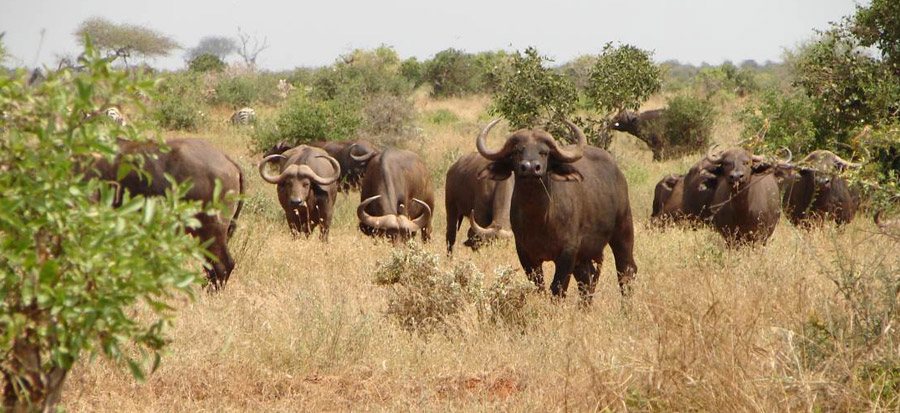
The sight of dust-red elephants wallowing, rolling, and spraying each other with the midnight blue waters of the palm-shaded Galana River is one of the most evocative images in Africa.
This, along with the 300-kilometer-long Yatta Plateau, the most extended lava flow in the world, makes for an adventure unlike any other in the Tsavo East. The park forms the largest protected area in Kenya. It is home to most of the larger mammals, vast herds of dust—red elephant, Rhino, Buffalo, lion, leopard, pods of hippo, crocodile, waterbucks, lesser Kudu, and gerenuk—and prolific birdlife featuring 500 recorded species.
Key features
Wildlife
- The park is home to most of the larger mammals and vast herds of dust—red elephant, Rhino, Buffalo, lion, leopard, pods of hippo, crocodile, waterbucks, Lesser Kudu, Gerenuk, and Hirola.
Birds
- The prolific bird life features 500 recorded species.
How to get there
- Roads: The Park Mtito Andei Gates is 233 km South of Nairobi and 250 km North of Mombasa on the main Nairobi- Mombasa Road. Distance Nairobi-Mtito Andei: 233 km – Mtito Andei-Voi: 96 km – Voi-Mombasa: 153 km. From Malindi, take the western road (C103) and enter the Park via Sala gate.
- Airstrips: Voi, Aruba, Satao, Sala, Ithumba, Sangayaya, Mopeo, Bachuma, Cottars.
#10. Tsavo West National Park
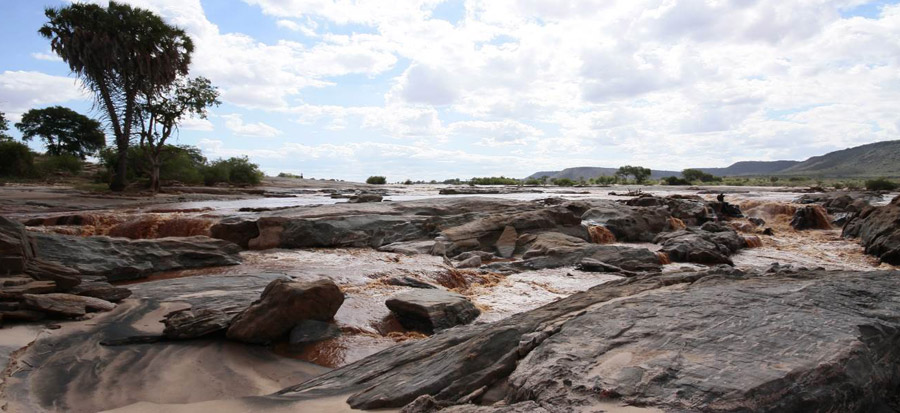
From the sight of fifty million gallons of crystal clear water from the under-parched lava rock that is the Mzima Springs to the Shetani lava flows, Tsavo West is a beautiful, rugged wilderness. The savannah ecosystem comprises open grasslands, scrublands, Acacia woodlands, belts of riverine vegetation, and rocky ridges, including the Poachers.
Tsavo West offers some of the most magnificent game viewing in the world. Attractions include elephants, rhinos, Hippos, lions, cheetahs, leopards, Buffalos, and diverse plant and bird species, including the threatened corncrake and near-threatened Basra Reed Warbler.
Attractions
- The spectacle of Mzima Springs is fifty million gallons of crystal clear water gushing out of the under-parched lava rocks, forming the most welcoming and lovely scene in Africa.
- Ancient lands of Lions, in189,8 the Uganda railway construction was abruptly halted when two of the most greedy and insatiable man-eating lions appeared upon the scene and waged intermittent warfare against the railway and all those connected with it in the vicinity of Tsav for over nine months.
- A vibrant volcanic area, the molten lava that forms Shetani lava spewed from the earth just about 200 years ago, and its fiery fury was thought by locals to be the work of the Devil.
- Poacher’s Lookout and roaring rocks; the park abounds as a panoramic vantage point from which to view the movement of the herds.
- Glorious game drives: Tsavo West offers some of the most magnificent game viewing in the world
- Ngulia Sanctuary is where the growing population of highly endangered black rhinos is inching away from the extinction chasm forced upon them by rampant poaching in the 1960s.
- Lake Jipe lies astride the Kenyan and Tanzanian borders. It is teeming with aquatic life, and bird watching is a major activity around the lake.
- First World War Site-East African Campaign: Perhaps the most bizarre campaign of the world war was fought in the “Bundu” (Bush) – the barely explored wilderness of thorny scrub and dense forest of Tsavo west. This last ‘gentleman war was waged under the code of honor-sometimes or guerilla tactics adopted by African tribal fighters. The Guided tours of the Crater, Kichwa Tembo, and Mzima efforts will enable you to trail the footsteps of the World War veterans.
How to get there
- Distance: 240 km from Nairobi, 250km from Mombasa (Mtito Andei Gate).
- By air: There are three airstrips in the park.
- Gates: Tsavo, Lake Jipe, Mtito Andei (Kamboyo HQ), Chyulu, Maktau, and Ziwani.
- Roads: The primary access routes are Chyulu Gate from Amboseli and Mtito Andei Gate from Nairobi.
- Visitors from Mombasa also use Tsavo Gate near Manyani.
- The park can also be reached via Taveta – Voi road through Maktau, Ziwani, and Jipe Gates.
- Airstrips: Kamboyo, Kilaguni, Tsavo Gate, Jipe, Kasigau, Finch Hottons, Ziwani, and Maktau airstrips are suitable.
For pricing, you can check out the Kenya Wildlife Services website.
You can also check the best places to visit: Nairobi, Nyeri, Nakuru, and Mombasa.
